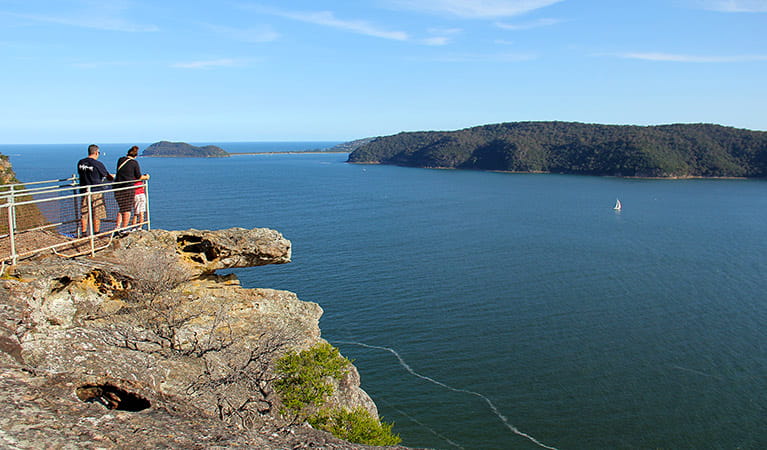Brisbane Water National Park
Brisbane Water National Park, near Gosford on the central coast offers great walks, cycling and fishing spots. The park protects ancient Aboriginal rock engraving sites.
Read more about Brisbane Water National Park
Brisbane Water National Park is on the central coast near Gosford, north of Sydney. The park offers a range of wonderful experiences, making it a great daytrip or weekend away from the city.
Come to see colourful spring wildflowers, ancient Aboriginal engraving sites and scenic views from the park's lookouts. There are great fishing spots to discover, along with walking and cycling trails that cross rainforest and rugged sandstone country. The park's waterways are a great place to spend a day on the water, so don't forget your kayak.
Head to one of the coastal towns, like Umina Beach to organise your lunch before finding your own scenic picnic spot, or make a stop at Patonga for some tasty fish and chips and a beach view.
Local alerts
For the latest updates on fires, closures and other alerts in this area, see https://www.nationalparks.nsw.gov.au/visit-a-park/parks/brisbane-water-national-park/local-alerts
Map
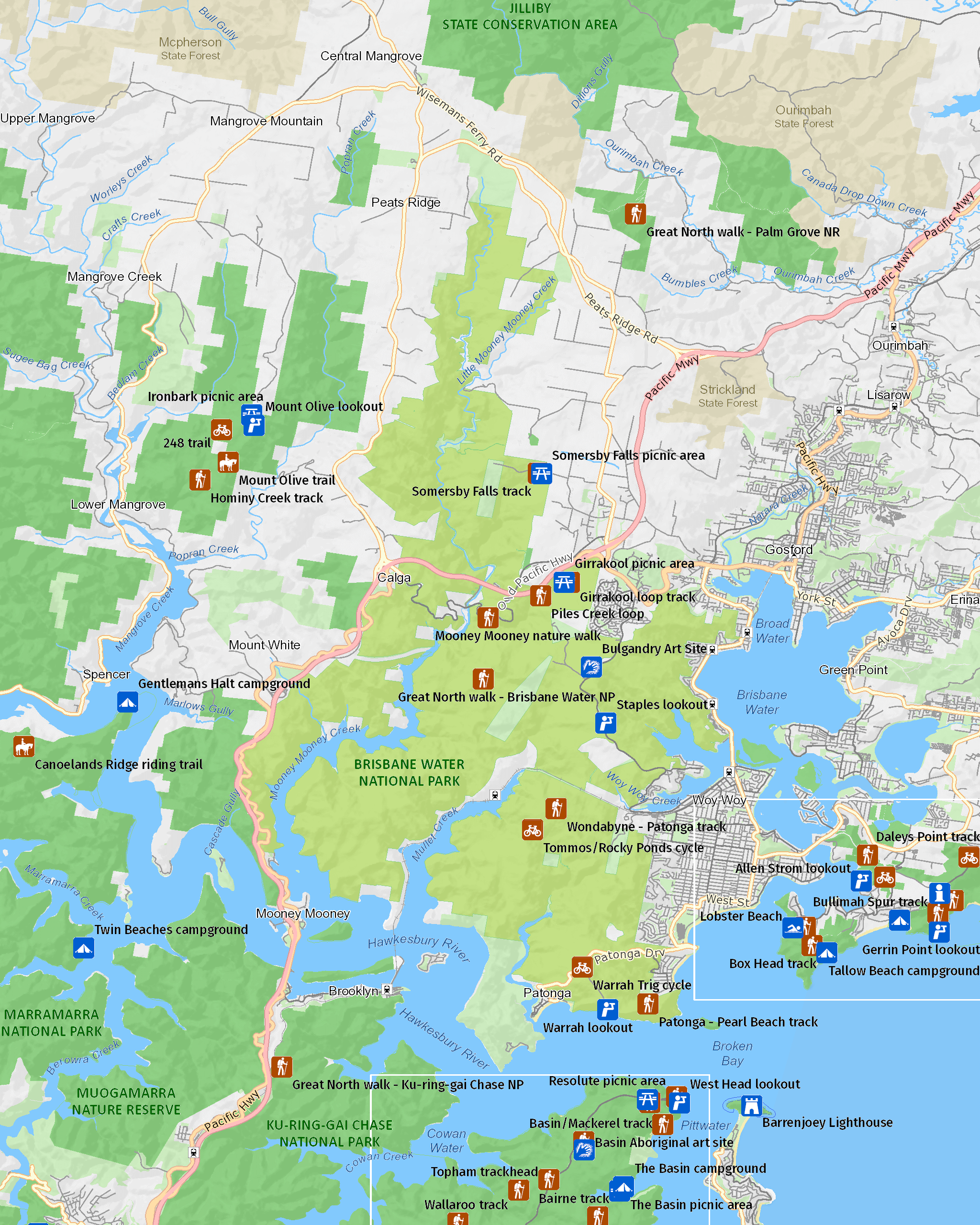
Map legend

Contact
- in the Sydney and surrounds region
Two picnic areas in Brisbane Water National Park close in the evening:
- Girrakool picnic area is open 7am to 8pm during daylight savings and is open 7am to 6pm at other times
- Somersby Falls picnic area is open 8am to 8pm during daylight savings and is open 8am to 5pm at other times
Other areas of Brisbane Water National Park will be open at all times, however may have to close at times due to poor weather or fire danger.
-
Park entry fees:
$8 per vehicle per day. The park has pay machines that accept both card and coins, or you can pay via the Park'nPay app.
Other fees:
You will need a permit to hold a wedding or undertake commercial photography within the park.
Buy annual pass -
-
Girrakool office
02 4320 4200
Contact hours: Monday to Friday, hours vary. - 59 Girrakool Rd, Somersby, NSW 2250
-
Email: npws.centralcoast@environment.nsw.gov.au
-
Girrakool office
-
-
Lake Munmorah office
02 4972 9000
Contact hours: Monday to Friday, 8.30am to 4pm. - 1 Blue Wren Drive, Wybung NSW 2259
-
Email: npws.centralcoast@environment.nsw.gov.au
-
Lake Munmorah office
Visitor info
All the practical information you need to know about Brisbane Water National Park.
Getting there and parking
Get driving directions
Brisbane Water National Park is located on the central coast near Gosford. Take the Central Coast Highway exit off the F3, followed by Wisemans Ferry Road for Somersby Falls and Girrakool, or Woy Woy Road for Patonga. Look for more information at the attraction you'd like to visit.
Parking
- Bulgandry Art Site Aboriginal Place See on map
- Girrakool picnic area See on map
- Staples lookout See on map
Road quality
- Sealed roads
Vehicle access
- 2WD vehicles
By bike
Check out the Bicycle information for NSW website for more information.
By public transport
For information about public transport options, visit the NSW transport info website or the Palm Beach and Hawkesbury River Cruises website.
Best times to visit
There are lots of great things waiting for you in Brisbane Water National Park. Here are some of the highlights.
Autumn
The cooler weather makes it a perfect time to find a waterfall walking track, and keep an eye out for ancient Aboriginal engravings along the way.
Spring
Pack a picnic lunch and soak up the delightful sights and sounds of spring. Relax among the wildflowers and wildlife as the Hawkesbury River flows by.
Summer
Take advantage of the warmer summer weather and paddle down Patonga Creek or Mooney Mooney Creek in a canoe.
Weather, temperature and rainfall
Summer temperature
Average
15°C and 27°C
Highest recorded
43.8°C
Winter temperature
Average
5°C and 19°C
Lowest recorded
-4.2°C
Rainfall
Wettest month
March
Driest month
September
The area’s highest recorded rainfall in one day
218.4mm
Facilities
Toilets
Picnic tables
Barbecue facilities
Drinking water
Maps and downloads
Fees and passes
Park entry fees:
$8 per vehicle per day. The park has pay machines that accept both card and coins, or you can pay via the Park'nPay app.
Other fees:
You will need a permit to hold a wedding or undertake commercial photography within the park.
- All Parks Pass - For all parks in NSW (including Kosciuszko NP) $190 (1 year) / $335 (2 years)
- Multi Parks Pass - For all parks in NSW (except Kosciuszko) $65 (1 year) / $115 (2 years)
- Country Parks Pass - For all parks in Country NSW (except Kosciuszko) $45 (1 year) / $75 (2 years)
- Single Country Park Pass - For entry to a single park in country NSW (except Kosciuszko). $22 (1 year) / $40 (2 years)
Annual passes and entry fees (https://www.nationalparks.nsw.gov.au/passes-and-fees)
Prohibited
Camp fires and solid fuel burners
Open fires and any form of solid fuel are not allowed.
Pets
Pets and domestic animals (other than certified assistance animals) are not permitted. Find out which regional parks allow dog walking and see the pets in parks policy for more information.
Smoking
NSW national parks are no smoking areas.
Nearby towns
Gosford (10 km)
Gosford is a great destination for a family day trip or holiday. It's situated on Brisbane Water National Park and surrounded by state forests, lakes and beaches.
Woy Woy (13 km)
Pack your swimmers for Woy Woy, which lays on a shallow inlet on the western shore of Brisbane Water National Park. The stunning beaches of Ettalong Beach, Umina Beach and the exclusive Pearl Beach are also close by.
Sydney City Centre (72 km)
No trip to Sydney is complete without spending some time in the city’s beautiful parks. Whether it’s in central areas like Hyde Park or the Royal Botanic Gardens or further out in Centennial Parklands, there’s plenty of green space to go out and enjoy.
Learn more
Brisbane Water National Park is a special place. Here are just some of the reasons why:
Stretch your legs
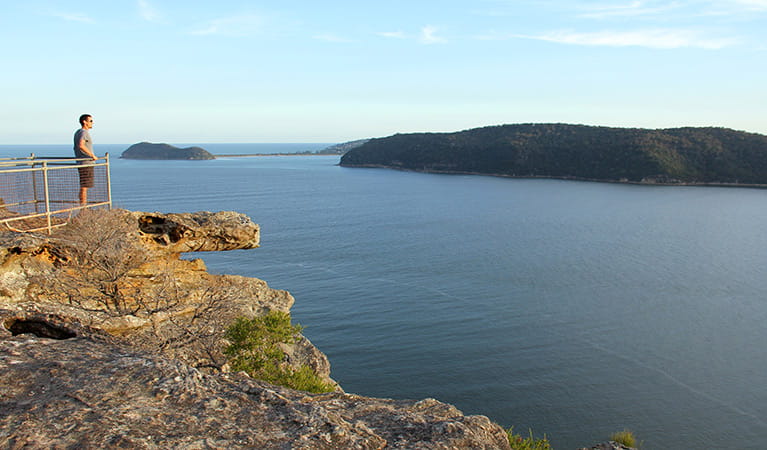
Brisbane Water National Park offers great ways to get amongst nature. Why not hop on your mountain bike and get your adrenalin pumping along the Tommos loop and Rocky Ponds cycling route? Or you can wear out your walking shoes along the Girrakool loop walking track. For the more energetic, the park is a hikers delight. Longer treks range from an hour or two to overnight on sections of the Great North walk, which passes through the park on its way from Sydney to Newcastle.
- Girrakool picnic area A great spot for a family picnic, Girrakool picnic area has barbecues, lots of green space to run around and a scenic walking track that features Aboriginal engravings.
- Great North walk - Brisbane Water National Park You’ll find the Wondabyne to Patonga and Patonga to Pearl Beach parts of the iconic Great North walk in Brisbane Water National Park. Take a short walk or overnight hike.
Ancient landscapes
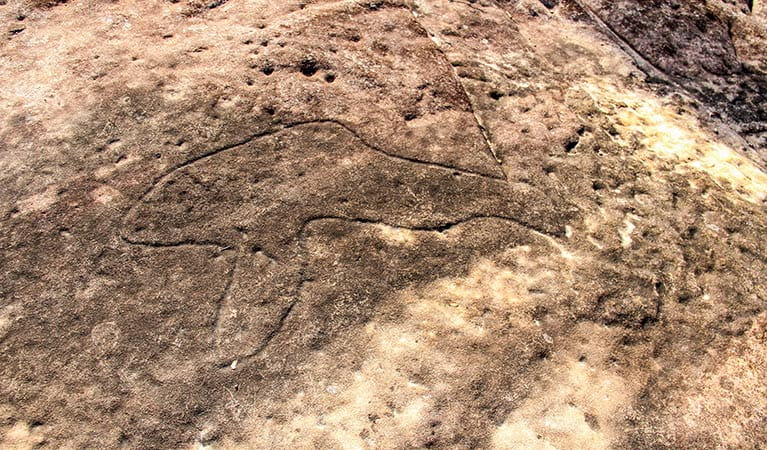
Aboriginal people in the area have a long association with the landscape of Brisbane Water National Park and much evidence of this remains today in the form of rock engravings, foreshore middens and rock paintings. The flat, exposed areas of Hawkesbury sandstone within the park provide an ideal 'canvas' for Aboriginal artists, and there are hundreds of rock engraving sites throughout the park. Aboriginal sites on Hawkesbury sandstone have a distinctive style of engraving which is unique in Australia. The Bulgandry Aboriginal engraving site at Kariong is an excellent example of rock art within the park and is easily accessible.
- Aboriginal culture Bring your students to this unique excursion in Brisbane Water National Park, near Gosford. They’ll experience the park through the eyes of an Aboriginal person on this Stage 2 (Years 3-4) Aboriginal culture Geography excursion.
- Girrakool loop track A lovely way to finish a barbecue, the Girrakool loop track is a short and easy walk through bushland, featuring an Aboriginal rock engraving site and scenic waterfalls.
- The Earth’s environment Join The Earth's environment Geography excursion for Stage 2 (Years 3-4) at Brisbane Water National Park, near Gosford. Students will discover how NSW National Parks safeguards over 10 per cent of land in NSW.
A wonderland of wildflowers
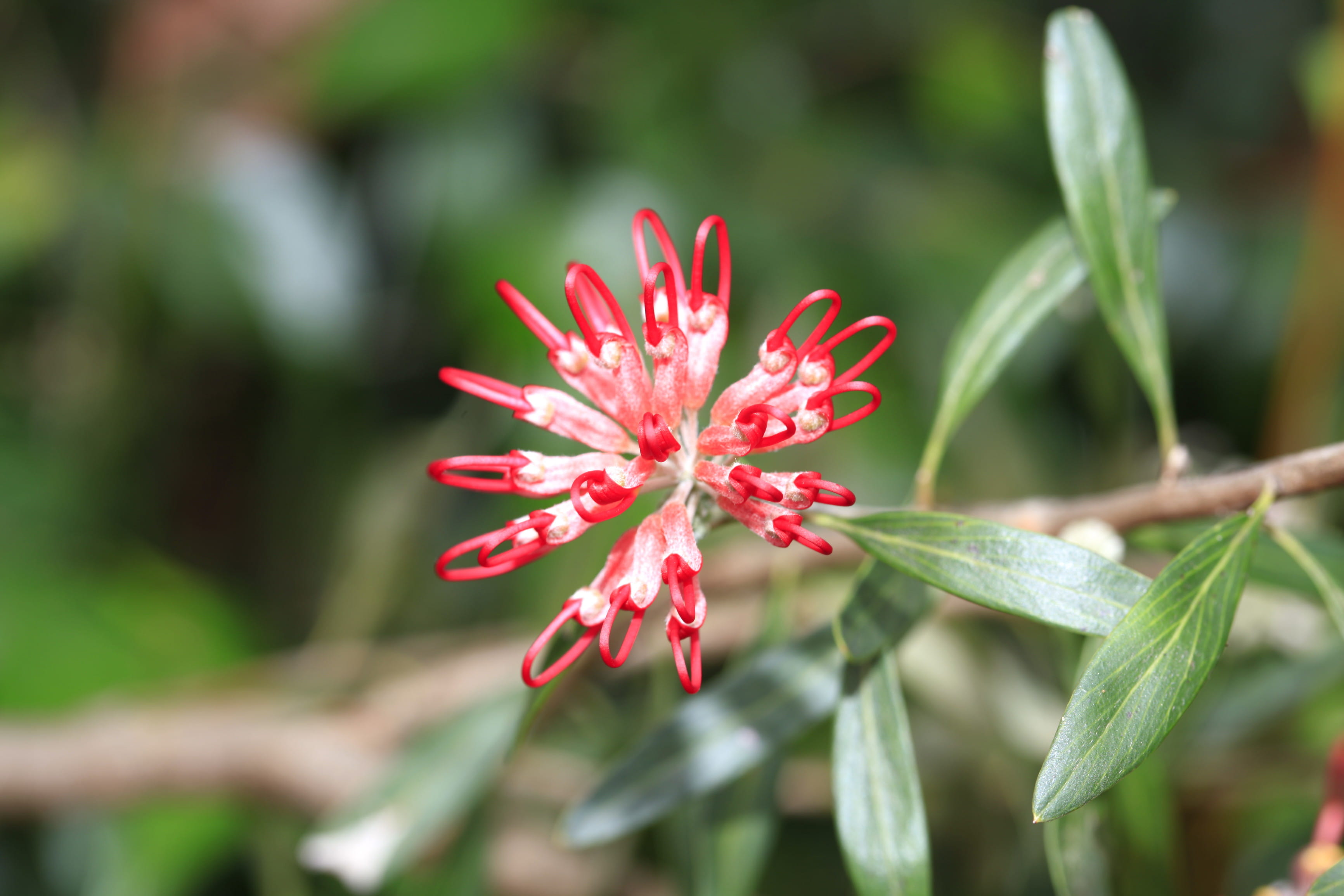
Located 12km from Gosford, the park covers 12,000ha of rugged sandstone country, and boarders the Hawkesbury river, which feeds cascading waterfalls. The landscape is gorgeous all year round, especially from late winter to early spring when it comes alive with colourful wildflowers.
- Great North walk stage 10: Brisbane Water dreaming Complete the Great North walk challenge with the tenth and final leg of the series. You’ll walk 18km from Kariong to Somersby, exploring the serene waterways of Brisbane Water National Park.
- Great North walk stage 8: Waratah spectacular Panoramic views of Sydney’s northern coastline await you on stage 8 of the Great North walk. The 20km guided tour through Brisbane Water National Park starts at Patonga and ends at Wondabyne Station.
- Great North walk stage 9: Rainforest walk Stage 9 of the Great North walk takes you into the temperate rainforest of Brisbane Water National Park. The 16km guided tour starts at Wondabyne Station and ends at Kariong.
- Somersby Falls picnic area A great place to picnic on the Central Coast, Somersby Falls offers barbecues and picnic tables in a lush rainforest complete with waterfalls and a walking track.
- Warrah lookout Warrah lookout, offering scenic views of Broken Bay and the Hawkesbury River, is just a short walk from the carpark. It’s a great place to see Waratahs in season.
A haven for wildlife
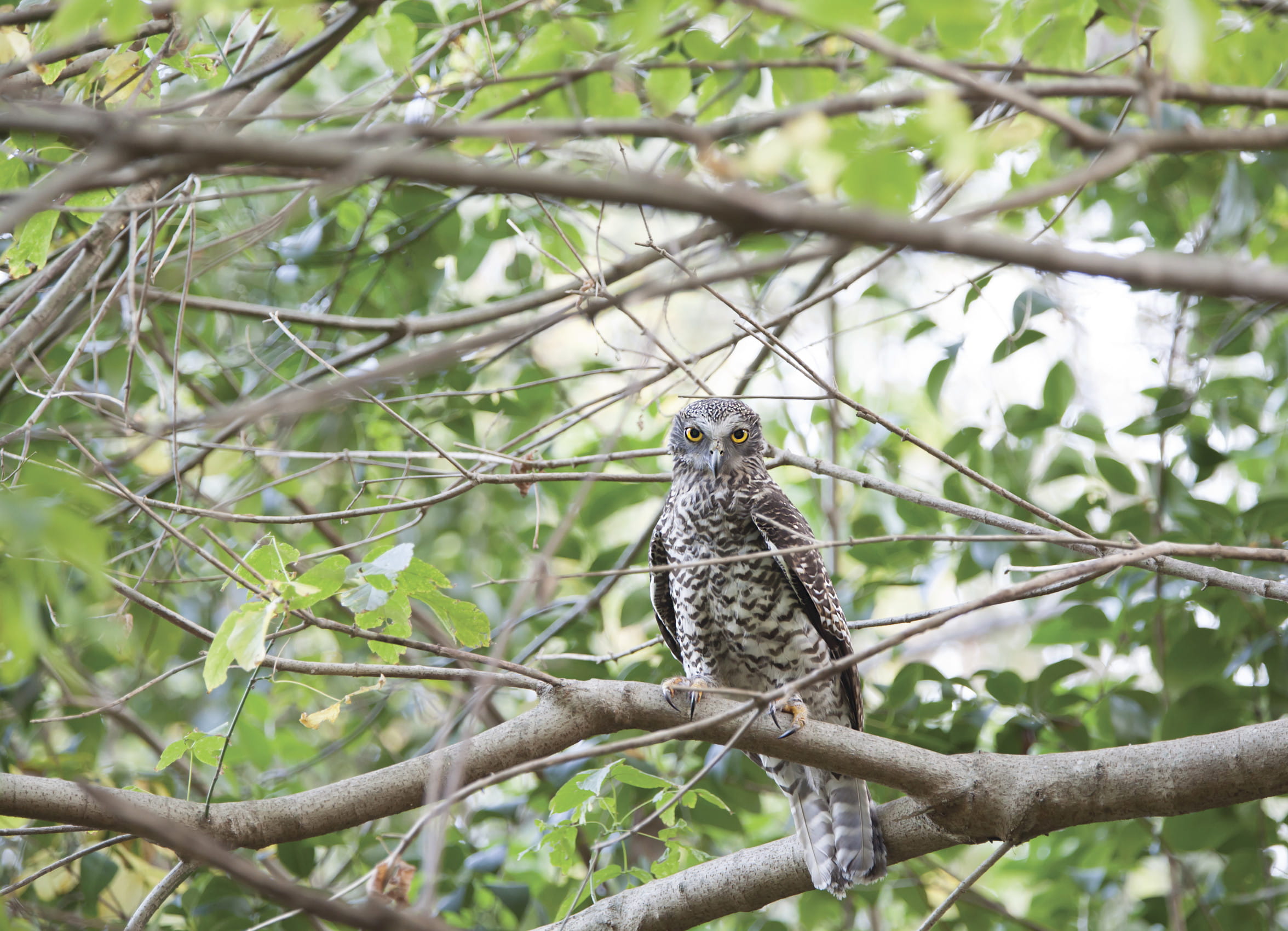
Brisbane Water National Park is home to an incredible 270 native animal species. Keep your eyes peeled for wildlife and bird life such as the threatened spotted tailed quoll, the rare glossy black cockatoo and powerful owl. You might be lucky enough to share a picnic at Girrakool picnic area with a few wallabies who love this peaceful place.
- Girrakool loop track A lovely way to finish a barbecue, the Girrakool loop track is a short and easy walk through bushland, featuring an Aboriginal rock engraving site and scenic waterfalls.
- Great North walk stage 8: Waratah spectacular Panoramic views of Sydney’s northern coastline await you on stage 8 of the Great North walk. The 20km guided tour through Brisbane Water National Park starts at Patonga and ends at Wondabyne Station.
- Great North walk stage 9: Rainforest walk Stage 9 of the Great North walk takes you into the temperate rainforest of Brisbane Water National Park. The 16km guided tour starts at Wondabyne Station and ends at Kariong.
- The Earth’s environment Join The Earth's environment Geography excursion for Stage 2 (Years 3-4) at Brisbane Water National Park, near Gosford. Students will discover how NSW National Parks safeguards over 10 per cent of land in NSW.
- Tommos loop and Rocky Ponds cycling loop Mountain biking enthusiasts will enjoy the challenging Tommos loop and Rocky Ponds cycling loop, a 20km bushland ride taking in scenic Central Coast views.
Plants and animals protected in this park
Animals
-
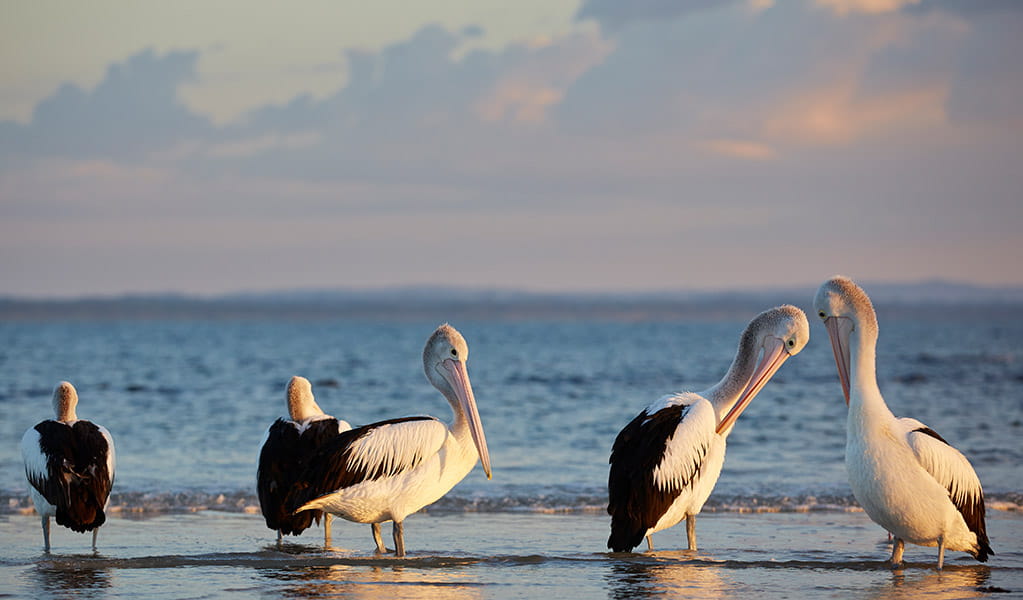
Australian pelican (Pelecanus conspicillatus)
The curious pelican is Australia’s largest flying bird and has the longest bill of any bird in the world. These Australian birds are found throughout Australian waterways and the pelican uses its throat pouch to trawl for fish. Pelicans breed all year round, congregating in large colonies on secluded beaches and islands.
-
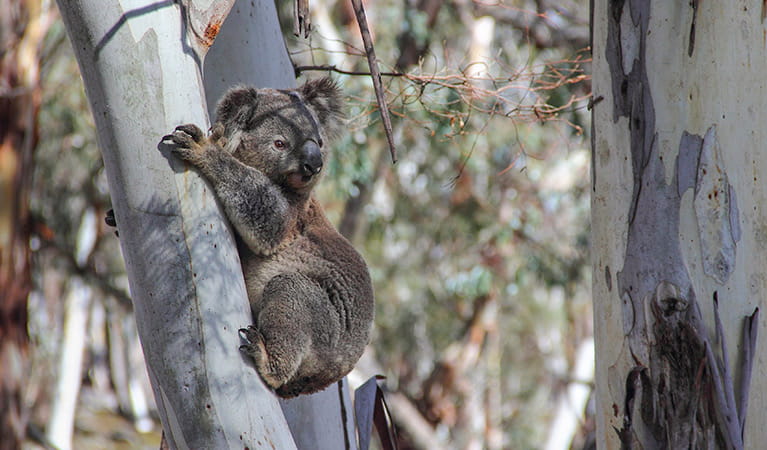
Koala (Phascolarctos cinereus)
One of the most renowned Australian animals, the tree-dwelling marsupial koala can be found in gum tree forests and woodlands across eastern NSW, Victoria and Queensland, as well as in isolated regions in South Australia. With a vice-like grip, this perhaps most iconic but endangered Australian animal lives in tall eucalypts within a home range of several hectares.
-
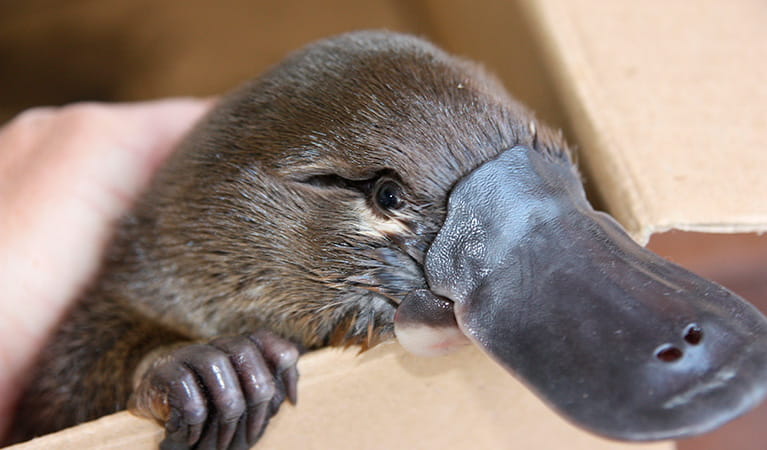
Platypus (Ornithorhynchus anatinus)
One of the most fascinating and unusual Australian animals, the duck-billed platypus, along with the echidna, are the only known monotremes, or egg-laying mammals, in existence. The platypus is generally found in permanent river systems and lakes in southern and eastern NSW and east and west of the Great Dividing Range.
Plants
-
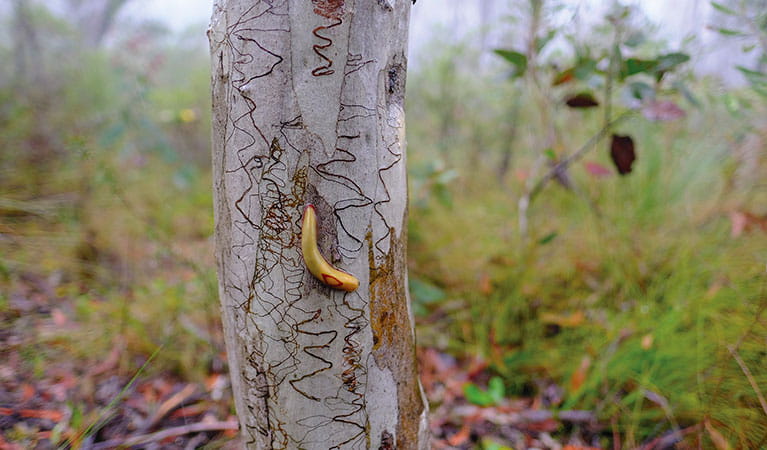
Scribbly gum (Eucalyptus haemastoma)
Easily identifiable Australian native plants, scribbly gum trees are found throughout NSW coastal plains and hills in the Sydney region. The most distinctive features of this eucalypt are the ‘scribbles’ made by moth larva as it tunnels between the layers of bark.
-
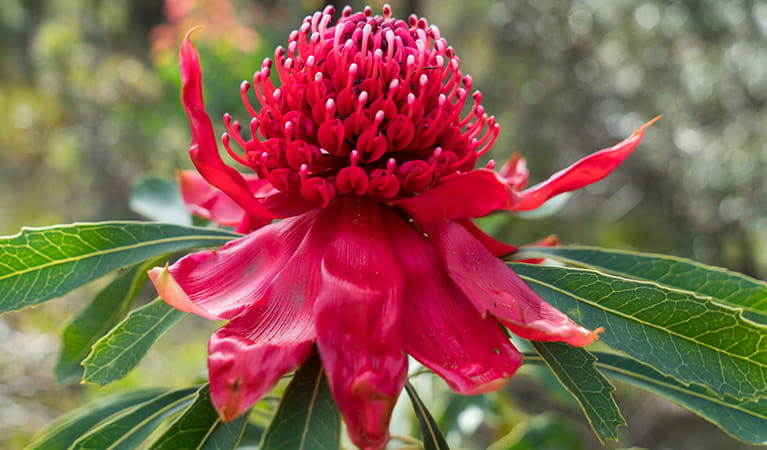
Waratah (Telopea speciosissima)
The beautiful waratah is not only the NSW floral emblem, it's also one of the best-known Australian native plants. This iconic Australian bush flower can be found on sandstone ridges around Sydney, in nearby mountain ranges and on the NSW South Coast. The waratah has a vibrant crimson flowerhead, measuring up to 15cm across, and blossoms in spring.
Environments in this park
Education resources (1)
School excursions (2)
- Aboriginal culture, Stage 2 (Years 3-4), Geography
- The Earth’s environment, Stage 2 (Years 3-4), Geography
What we're doing
Brisbane Water National Park has management strategies in place to protect and conserve the values of this park. Visit the OEH website for detailed park and fire management documents. Here is just some of the work we’re doing to conserve these values:
Preserving biodiversity
Preserving biodiversity is a fundamental NPWS focus, and managing bushfire is a key component of this. Fire management plans are regularly prepared for and implemented in Brisbane Water National Park in order to protect threatened species.
Managing weeds, pest animals and other threats
Pests and weeds have a significant impact to the ecosystems within Brisbane Water National Park. Pest management is a priority for NPWS with the pest reduction of foxes and wild dogs being an important part of work undertaken to protect the integrity of biodiversity within this park. Risk assessments for new and emerging weeds are carried out as an ongoing initiative in Brisbane Water.
Developing visitor facilities and experiences
Brisbane Water National Park is dedicated to providing first-class facilities for all of its visitors. Enhancements to tracks, trails, steps and platforms are ongoing in this park.
NSW National Parks and Wildlife Service (NPWS) is currently undertaking infrastructure projects to enhance visitor facilities and create new, iconic visitor experiences in our national parks. These projects aim to increase nature-based tourism in NSW, to boost regional visitor economies and improve community wellbeing.
Managing fire
NSW is one of the most bushfire prone areas in the world as a result of our climate, weather systems, vegetation and the rugged terrain. NPWS is committed to maintaining natural and cultural heritage values and minimising the likelihood and impact of bushfires via a strategic program of fire research, fire planning, hazard reduction, highly trained rapid response firefighting crews and community alerts.
General enquiries
- National Parks Contact Centre
- 7am to 7pm daily
- 1300 072 757 (13000 PARKS) for the cost of a local call within Australia excluding mobiles
- parks.info@environment.nsw.gov.au
Contact
- in the Sydney and surrounds region
Two picnic areas in Brisbane Water National Park close in the evening:
- Girrakool picnic area is open 7am to 8pm during daylight savings and is open 7am to 6pm at other times
- Somersby Falls picnic area is open 8am to 8pm during daylight savings and is open 8am to 5pm at other times
Other areas of Brisbane Water National Park will be open at all times, however may have to close at times due to poor weather or fire danger.
-
Park entry fees:
$8 per vehicle per day. The park has pay machines that accept both card and coins, or you can pay via the Park'nPay app.
Other fees:
You will need a permit to hold a wedding or undertake commercial photography within the park.
Buy annual pass -
-
Girrakool office
02 4320 4200
Contact hours: Monday to Friday, hours vary. - 59 Girrakool Rd, Somersby, NSW 2250
-
Email: npws.centralcoast@environment.nsw.gov.au
-
Girrakool office
-
-
Lake Munmorah office
02 4972 9000
Contact hours: Monday to Friday, 8.30am to 4pm. - 1 Blue Wren Drive, Wybung NSW 2259
-
Email: npws.centralcoast@environment.nsw.gov.au
-
Lake Munmorah office

